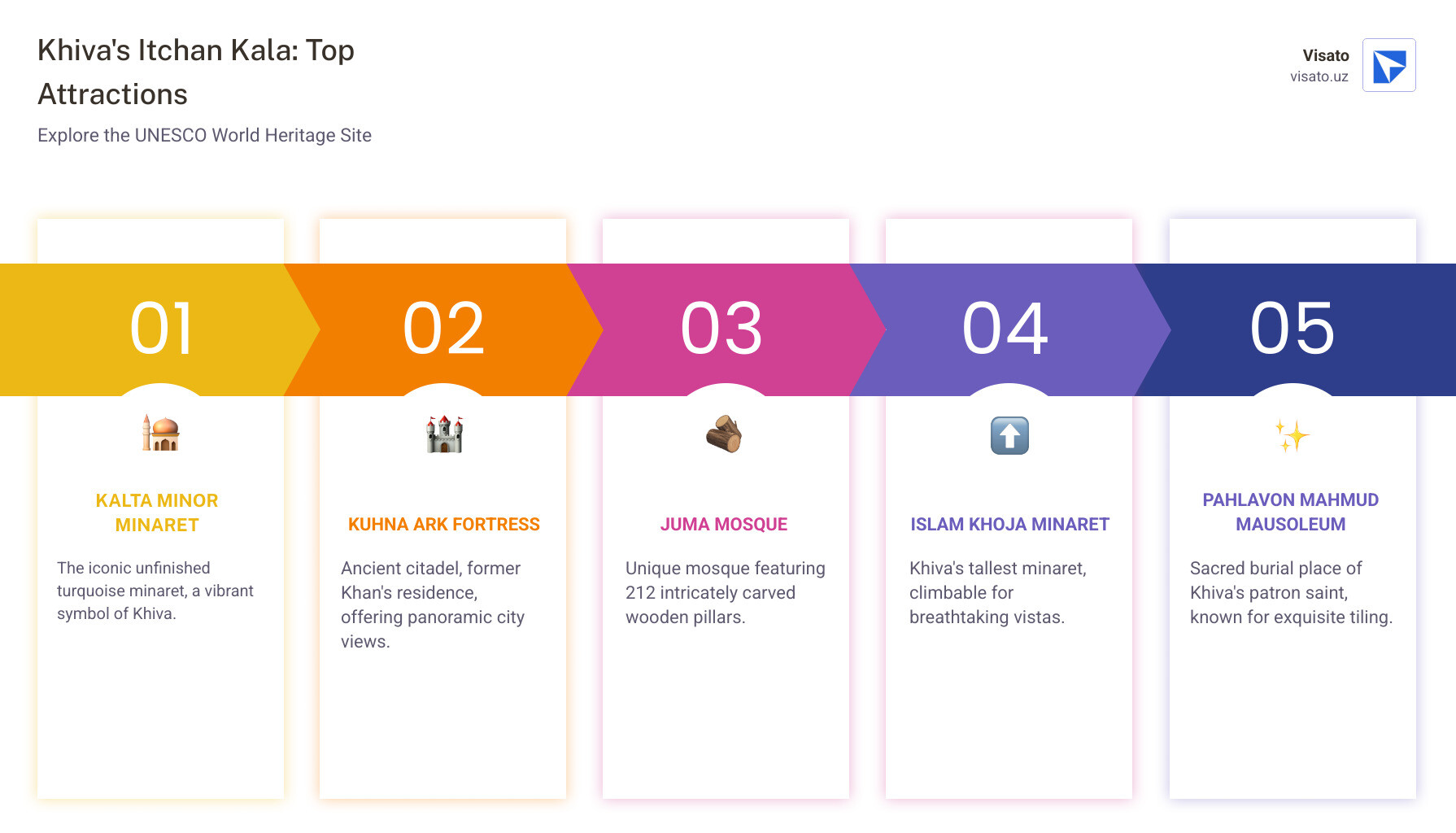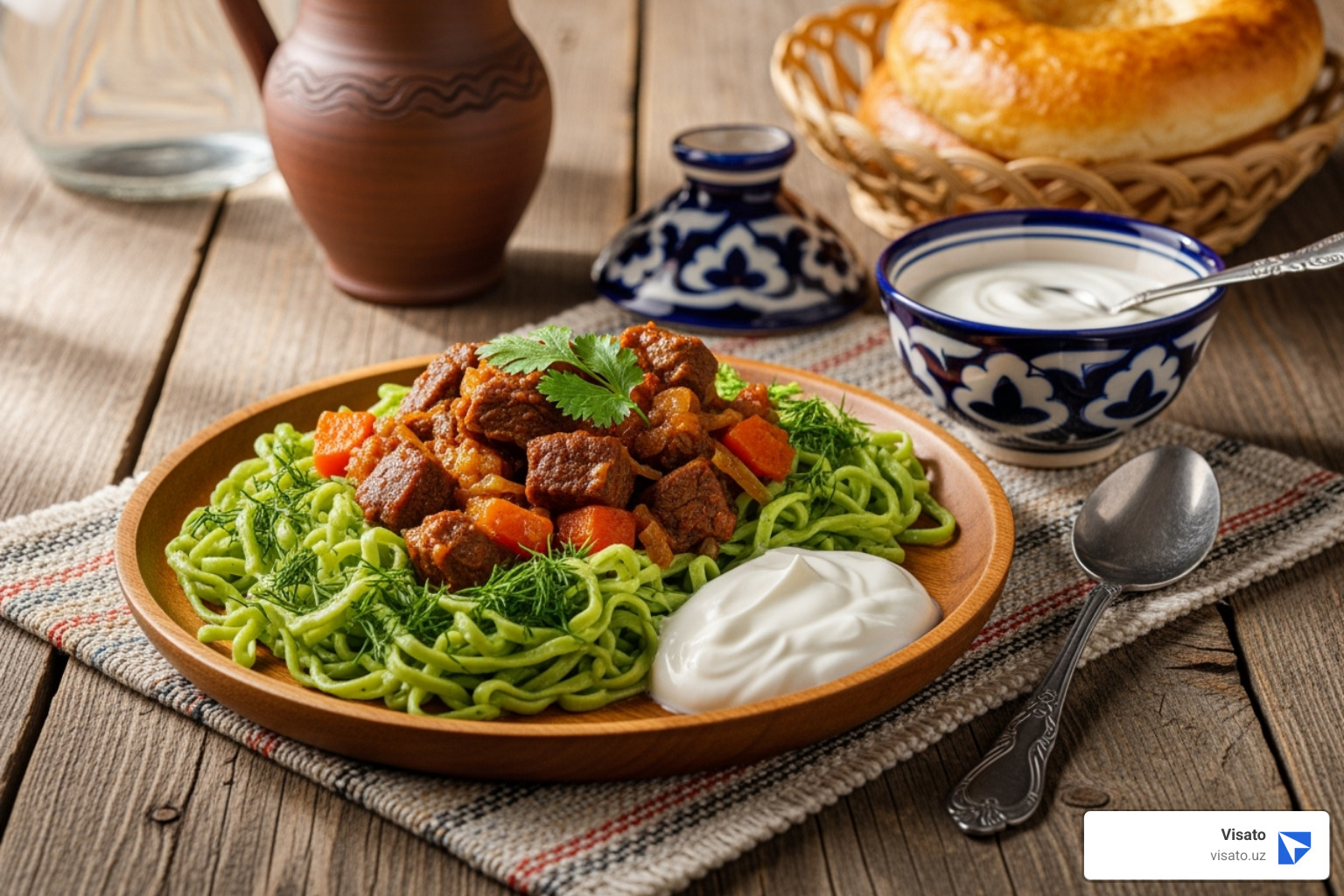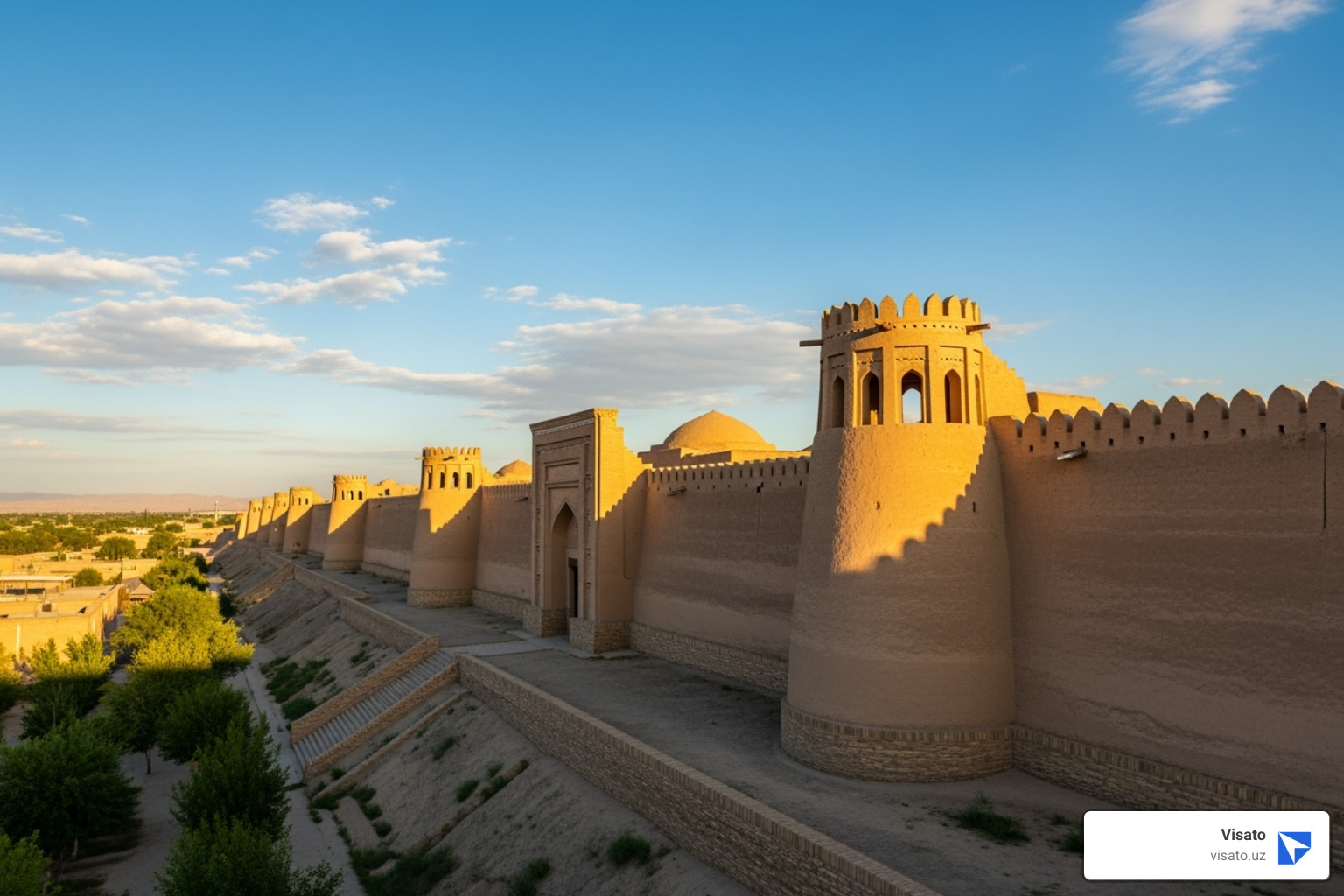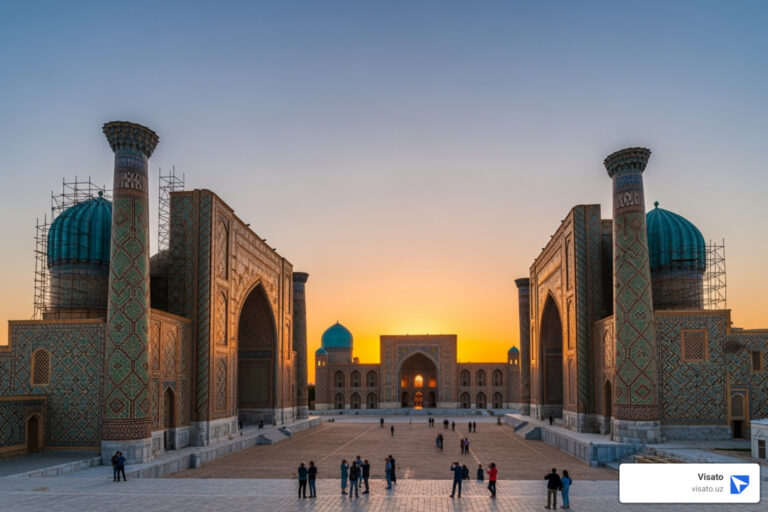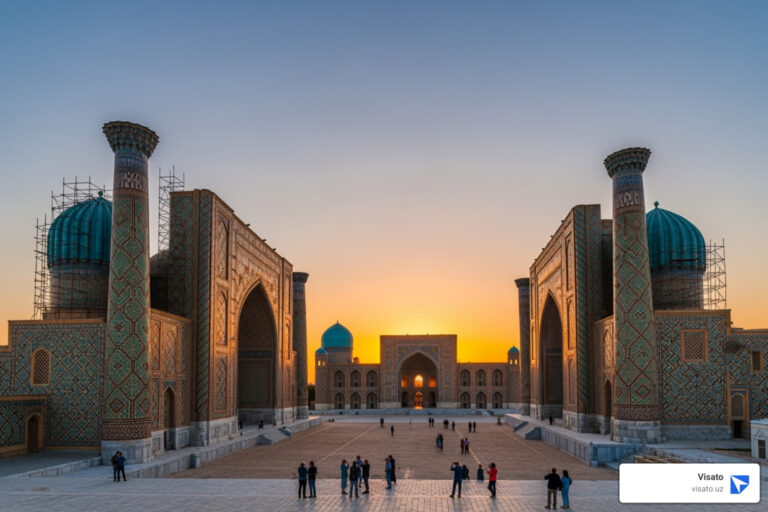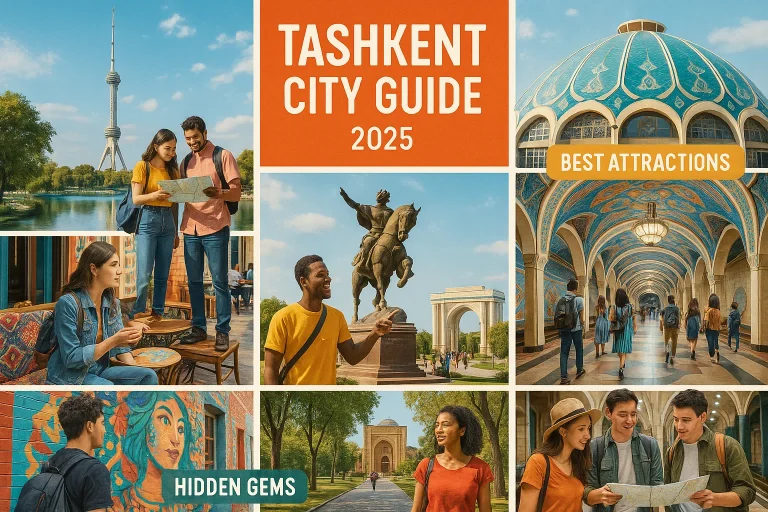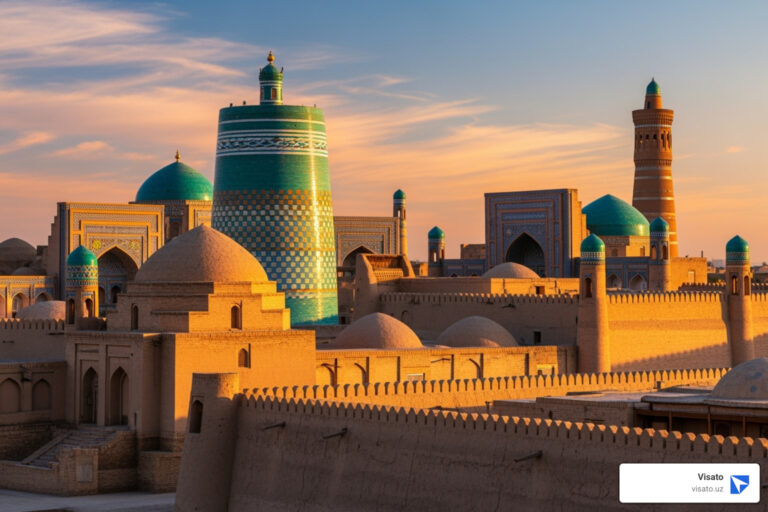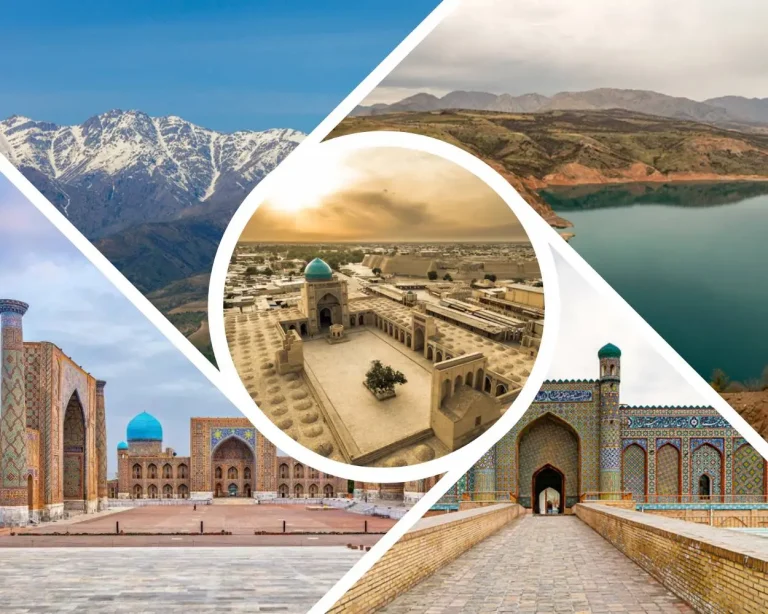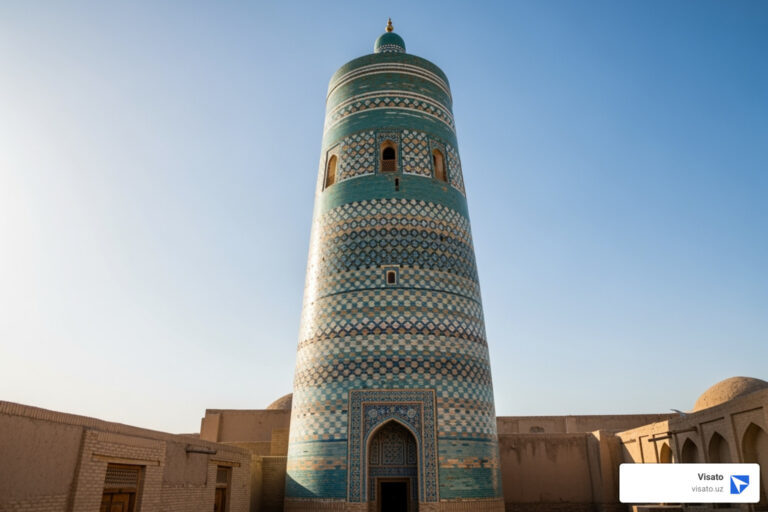Why Khiva Deserves a Top Spot on Your Uzbekistan Itinerary
A Khiva travel guide begins with a simple truth: this ancient Silk Road city is one of Central Asia’s most perfectly preserved medieval townscapes. While Samarkand has grand monuments and Bukhara has busy bazaars, Khiva offers a compact, walkable open-air museum where history feels alive.
Quick Facts for Planning Your Khiva Visit:
- Location: Khorezm region, western Uzbekistan
- Main Attraction: Itchan Kala, a UNESCO World Heritage Site
- Recommended Stay: 2-3 days
- Best Time: April-May or September-October
- Entry Ticket: Approx. 150,000-200,000 UZS (valid 2 days)
- Getting There: Fly to Urgench (30 min drive) or take a train
- Visa: 90+ nationalities can enter Uzbekistan visa-free for 30 days
The city’s core, Itchan Kala, contains over 50 historical monuments within its 2,500-year-old walls. It’s an intimate space where you can walk from the turquoise Kalta Minor Minaret to the ancient Juma Mosque in minutes. But it’s no sterile museum; around 3,000 people still live here, and you’ll see daily life unfolding against a backdrop of ancient architecture, especially in the early morning.
Khiva’s history is darker than its fairytale appearance suggests, once being a notorious slave trading post. Today, that brutal past contrasts sharply with the warm, welcoming atmosphere for visitors.
I’m Nariman Huseynov from Visato.uz. Having helped thousands of travelers plan their Silk Road adventures, this Khiva travel guide combines visitor feedback with practical advice to make your journey seamless.
Why Khiva is an Unforgettable Silk Road Jewel
Many travelers almost skip Khiva due to its remote location in the far western Khorezm region, but it often becomes the most memorable stop on their Uzbekistan journey. After helping thousands of visitors plan their trips through Visato.uz, I can tell you the detour is worth it.
Khiva was Uzbekistan’s first UNESCO World Heritage Site (1990) for good reason. It was a vital Silk Road oasis where caravans rested after crossing the brutal Karakum Desert. For centuries, it was the capital of the powerful Khanate of Khiva, and that wealth is evident in every turquoise-tiled dome and carved wooden pillar. However, this prosperity was built on a dark history; Khiva operated one of Central Asia’s largest slave markets until 1917. Understanding this complexity makes the city’s present-day warmth all the more striking.
What makes Khiva unique? Unlike the sprawling monuments of Samarkand or the busy bazaars of Bukhara, Khiva offers a complete medieval city frozen in time. The entire Itchan Kala (inner city) covers just 26 hectares, completely encircled by ten-meter-high mud-brick walls. You can walk from one end to the other in fifteen minutes, making it incredibly intimate and easy to steer.
This compact preservation creates a feeling of stepping into another era. The architectural consistency is remarkable. While some criticize the 1970s Soviet-era restorations for being too polished, they likely saved these 2,500-year-old structures from crumbling. Today, the city feels remarkably safe and welcoming.
The real magic lies in the contrast between the museum-like Itchan Kala and the authentic Dichan Kala (the outer town), where most of the city’s 93,000 residents live. Step through the ancient gates, and you’ll find a world of neighborhood bakeries and locals going about their day. This unique combination of a preserved inner core and a living outer city is why Khiva is an unforgettable Silk Road jewel.
The Ultimate Khiva Travel Guide: Attractions & Experiences
Khiva’s Itchan Kala is a living open-air museum where every corner tells a story. This section of our Khiva travel guide will help you steer its treasures.
Must-See Sights Within Itchan Kala
To explore, you’ll need an entrance ticket for Itchan Kala. As of late 2024, the standard ticket costs around 200,000 SOM (approx. €15) and is valid for two days, granting access to most sites.
However, two top sights require separate tickets: climbing the Islam Khoja Minaret (approx. 100,000 SOM) for panoramic views and entering the sacred Pahlavon Mahmud Mausoleum (approx. 25,000 SOM). Both are highly recommended.
| Attraction | Included in Itchan Kala Ticket? | Additional Cost (Approx. Dec 2024) | Notes |
|---|---|---|---|
| Most Museums & Madrassas | Yes | — | Covers entry to many smaller sites. |
| Pahlavon Mahmud Mausoleum | No | 25,000 SOM (€1.90) | Highly recommended, sacred site. |
| Islam Khoja Minaret Climb | No | 100,000 SOM (€7.50) | Offers panoramic views. |
| Kuhna Ark Watchtower | Yes (usually) | — | Great for sunset views. |
| Tash Khauli Palace | Yes (usually) | — | Grand palace with harem. |
- Kalta Minor Minaret: Khiva’s most iconic symbol, this stunning, unfinished turquoise-tiled minaret is impossible to miss. Its construction halted abruptly in 1855, leaving a magnificent, stout structure.
- Kuhna Ark Fortress: The former residence of Khiva’s rulers. Explore the throne room and mosque, and be sure to climb the watchtower for a magical sunset view over Itchan Kala.
- Juma Mosque: A unique and atmospheric space defined by a forest of 212 intricately carved wooden columns, some dating back to the 10th century. Visit in the morning for a quiet, contemplative experience. For more details, see this resource on Khiva’s architecture.
- Islam Khoja Minaret: At 57 meters, this is Khiva’s tallest minaret. The 175-step climb is claustrophobic but rewards you with the best views of the city and surrounding desert.
- Pahlavon Mahmud Mausoleum: A sacred pilgrimage site and one of Khiva’s most beautiful buildings, honoring the city’s patron saint. Its turquoise domes and exquisite tilework are breathtaking. Remember to dress respectfully.
- Tash Khauli Palace: The “Stone Palace” offers a glimpse into 19th-century royal life, with over 150 rooms, opulent courtyards, and the infamous harem.
Exploring Beyond the Inner Walls
To enrich your experience, venture into Dichan Kala (the outer town), where most of Khiva’s residents live. Here you’ll find a blend of medieval and Soviet-era buildings, local bakeries, and authentic daily life. Also in Dichan Kala is the Nurullabai Palace, which features a surprising mix of traditional Khivan and European design.
If you have an extra day, consider a trip to the Ellik Kala (Fifty Fortresses), ancient ruins scattered across the desert. Sites like Ayaz Kala and Toprak Kala tell the story of the Khorezm region’s power long before Khiva’s prominence. A car for the day trip costs around $30.
Immersive Cultural Experiences
- Craftsmanship: Khiva is famed for its woodcarving and silk carpets. Visit a workshop like Khasanbai’s or the Khiva Silk Carpet Workshop to see masters at work, a tradition passed down through generations.
- Bazaar & Local Life: The bazaar within Itchan Kala is perfect for souvenir hunting (bargaining is expected!) and people-watching. For a truly authentic experience, simply find a bench or rooftop cafe and watch the city’s daily rhythms unfold.
- Food & Entertainment: Don’t leave without trying Shivit Oshi, Khiva’s signature green dill noodles. Many restaurants also offer traditional dance performances in the evening, providing a fun and entertaining look at local culture.
Planning Your Perfect Trip to Khiva
Logistics can make or break a trip. This part of our Khiva travel guide covers the essentials for planning your visit to this Silk Road jewel.
How to Get to Khiva
Despite its western location, Khiva is well-connected.
- By Air: The fastest way is to fly to Urgench (UGC), 30 km away. A flight from Tashkent takes 1.5 hours. From the airport, a taxi to Khiva takes 30 minutes (45,000-90,000 SOM).
- By Train: A comfortable overnight train runs from Tashkent. The train from Bukhara takes about seven hours. Book tickets in advance, especially in peak season. Check train schedules and book tickets here.
- By Shared Taxi: A popular and budget-friendly option for travel between cities. A seat from Bukhara costs around 100,000 SOM. Your guesthouse can help arrange this.
Best Time to Visit and Recommended Duration
The desert climate means timing is key. The best times to visit are the shoulder seasons: April-May and September-October, when the weather is pleasant for exploring. Summers are extremely hot (40°C+), and winters are very cold (-15°C).
Plan for at least two full days. While you can see the main sights in one rushed day, two days allow you to explore at a relaxed pace, enjoy sunrise and sunset, and soak in the atmosphere. Three days gives you time for a day trip to the desert fortresses.
A perfect two-day plan: On Day 1, explore the Kuhna Ark, Juma Mosque, and Tash Khauli Palace, ending with sunset from the watchtower. On Day 2, climb the Islam Khoja Minaret at sunrise, then explore the bazaar and craft workshops.
Where to Stay: From Budget Guesthouses to Historic Hotels
We strongly recommend staying inside Itchan Kala. The experience of wandering the empty, beautifully lit streets after the day-trippers have left is magical. Waking up inside the ancient walls at dawn is equally unforgettable.
Atmospheric options include hotels in converted madrassas like Orient Star Khiva. For great mid-range value, we enjoyed Islambek Hotel. The popular Meros B&B is another excellent choice, offering a cozy, authentic feel. Staying outside the walls in Dichan Kala offers more modern amenities and budget-friendly guesthouses.
A Foodie’s Khiva Travel Guide
Uzbek food is hearty and flavorful. In Khiva, you must try Shivit Oshi, the city’s signature green dill noodles topped with a meat stew. You’ll also find Uzbekistan’s national dish, Plov (rice with meat and carrots), and Lagman (hearty noodle soup) on every menu. Manti (dumplings) and samsa (pastries) make for great snacks.
For dining, Terrassa Cafe is famous for its unbeatable sunset views over Itchan Kala (go for drinks). For a better balance of food quality and value, try Khorezm Art Cafe. For an authentic experience, find a local chaikhana (tea house), the heart of Uzbek social life.
Practical Tips for Navigating Khiva
A few practical insights can make your visit to this ancient city even smoother. Here’s what you need to know to steer Khiva like a pro.
Your On-the-Ground Khiva Travel Guide
- Getting Around: Itchan Kala is a car-free zone best explored on foot; you can cross it in 15 minutes. For trips to the outer town or desert fortresses, your guesthouse can arrange an affordable taxi.
- Money: The currency is the Uzbek Som (UZS). Carry enough cash, as ATMs can be unreliable and many smaller shops, restaurants, and the bazaar are cash-only. Some larger hotels accept cards.
- Bargaining: Haggling at the bazaar is expected and part of the fun. Start by offering about half the asking price and negotiate with a smile.
- Local Customs: Dress modestly, covering shoulders and knees, especially when visiting mosques and mausoleums. Women should carry a scarf for head covering. Always remove your shoes before entering sacred sites.
- Photography: It’s generally welcomed, but always ask for permission before taking photos of people. A smile and a gesture go a long way.
- Connectivity: Buy a local SIM card (e.g., Ucell, Beeline) upon arrival for cheap and reliable data. It’s invaluable for maps and translation.
- Safety: Khiva is very safe, with a visible and helpful tourist police force. We felt comfortable walking around at any hour. Solo female travelers also report feeling very safe here. As always, use common sense and be aware of your belongings.
- Heat & Gear: In summer (June-August), temperatures exceed 40°C. Stay hydrated, wear a hat, and explore in the early morning and late afternoon. A power bank is essential for keeping your devices charged.
Uzbekistan Entry and Visa Information
Fortunately, Uzbekistan has made entering the country refreshingly simple.
Over 90 nationalities can now enter Uzbekistan visa-free for up to 30 days, including citizens of the UK, EU, USA, Canada, and Australia. This has made planning a Silk Road trip easier than ever.
For those who do need a visa, Uzbekistan’s e-visa system is efficient. At Visato.uz, we streamline this process, handling applications from start to finish. Our service delivers e-visas in as little as 2-3 business days, with 24/7 support.
- Check your requirements: Use our comprehensive guide to see if you need a visa: Uzbekistan e-visa requirements.
- Apply with ease: Our step-by-step walkthrough makes the application foolproof: Uzbekistan e-visa guide.
- Track your status: You can check your application’s progress in real-time.
Let us handle the bureaucracy so you can focus on the adventure. Having your visa sorted provides invaluable peace of mind.
Frequently Asked Questions about Visiting Khiva
Here are quick answers to the most common questions we receive for any Khiva travel guide.
How many days are enough for Khiva?
While you can see the main highlights in one packed day, we strongly recommend 2 to 3 days. This allows you to explore at a relaxed pace, experience the city’s magical atmosphere at sunrise and sunset, and truly appreciate its living history. A third day allows for a day trip to the nearby desert fortresses.
What is the entrance ticket system for Itchan Kala?
There is a standard entrance ticket for Itchan Kala that costs around 200,000 UZS (as of late 2024) and is valid for two consecutive days. This ticket grants access to most museums and monuments within the walled city.
However, two of the most popular experiences require separate tickets: climbing the Islam Khoja Minaret (for the best views) and entering the Pahlavon Mahmud Mausoleum (a beautiful sacred site). Both are worth the small extra cost.
Is Khiva safe for tourists?
Yes, Khiva is considered very safe for tourists, including solo female travelers. The government takes tourist safety seriously, and there is a dedicated, friendly tourist police force patrolling Itchan Kala. Crime against tourists is extremely rare. The local culture is warm and hospitable. As with any travel, standard precautions are advised, but you can explore with confidence.
If you have questions about your travel documents, our team at Visato.uz is here to help ensure your Uzbekistan e-visa process is smooth and worry-free.
Conclusion
Standing at the gates of Itchan Kala as the sun sets, it’s easy to see why Khiva has captivated travelers for centuries. This Khiva travel guide has shown you a city that is more than just a collection of monuments; it’s a living, breathing open-air museum.
What makes Khiva special is the way history feels present in the daily lives of its residents. It’s savoring green Shivit Oshi noodles, watching craftsmen at work, and experiencing the quiet magic of the streets at dawn. The city’s intimate scale allows for a connection that larger Silk Road cities can’t always match.
Through our work at Visato.uz, we’ve seen countless travelers fall in love with Khiva, often calling it the unexpected highlight of their Uzbekistan trip. It has a way of transporting you to another time.
Ready to explore the magic of Khiva and the Silk Road? First, ensure your travel documents are in order. Check your Uzbekistan e-visa requirements to see if you can enjoy visa-free travel. If you do need an e-visa, we’re here to make the process fast and simple—so you can spend less time on paperwork and more time dreaming of those turquoise domes.
The gates of Khiva are open. This living museum awaits.

